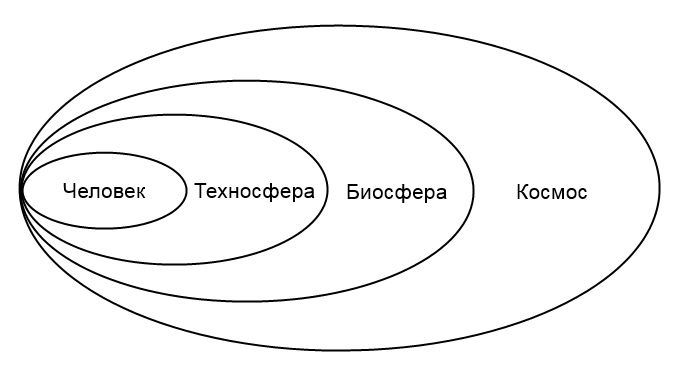Human is a sociobiological being formed in the process of evolution in the natural environment. In the course of life, a human being and the environment are constantly interacting with each other forming a system “man – habitat.”
The habitat is a human environment currently determined by a set of factors (physical, chemical, biological, social) that could have a direct or indirect, immediate or distant impact on human activities, health, and offspring.
During the long evolution, human has adapted to a particular quality of the natural environment, and any changes in it have certain impact on their health, even cause diseases.
In the life cycle, a human being and the habitat constantly interact and form a permanent system “man – habitat” in which a person realises their psychological and social needs.
As parts of the environment, there are natural, anthropogenic, industrial, and living environment. Each environment can be dangerous to humans.
Natural environment (Biosphere) is the area of distribution of life on Earth that has not experienced the anthropogenic impact (atmosphere, hydrosphere, the upper part of lithosphere). It has both a protective effect (protection of human from the negative factors: the difference in temperature, precipitation) and a number of negative factors. Therefore, to protect them from people had to create the anthroposphere.
Anthropogenic environment (Anthroposphere) is a habitat created by people and equipment affecting the natural environment in order to best fit the social and economic needs.
At the present stage of human development, the society constantly has been impacted the environment. The diagram representing human interaction with the environment is shown below.

In the 20th century, zones of high anthropogenic impact on the environment have appeared. This resulted in partial or complete degradation. These changes caused by the following evolutionary processes:
- population growth and an increase in urbanisation level
- energy consumption growth
- wide use of personal transport
- military spending increase.
Environmental science deals with such things as unmodified natural environment and modified environment.
Unmodified natural environment is a part of environment unaltered as a result of direct or indirect influence of human society and characterised by self-correction without human intervention. Such kind of environment provides the normal functioning of the human body.
Modified (polluted) natural environment is a part of environment changed as a result of its irrational use by humans in the normal course of their business and negatively affecting their health, working capability, living conditions. With regard to the modified environment, there are substantially identical terms used: anthropogenic, anthropic, manmade, unnatural environment.
Environmental elements have certain characteristics that specify their effect on humans or the need for them to provide a living environment.
Condition classification within the system “man – habitat”:
- Comfortable (optimal) conditions of work and rest. To these conditions humans are most adapted. The highest performance is observed, whereas preservation of health and integrity of the environment components are guaranteed.
- Acceptable. Characterised by deviation of flows of matters, energy and information from the nominal values within acceptable limits. These working conditions do not have a negative impact on health, but also lead to discomfort and a decrease in efficiency and productivity. It does not cause irreversible processes in a human body and the environment. Permissible values of exposure are specified by health and safety regulations.
- Dangerous. Flows of matter, energy and information exceed acceptable exposure level. It has a negative impact on human health. Prolonged exposure causes diseases and lead to degradation of the natural environment.
- Extremely dangerous. For a short period of exposure, flows can cause injury or death, leading to irreversible destruction of the natural environment.
Natural elements are characterised by their physical properties, chemical composition or biological agents. Thus, the air is defined by temperature, humidity, speed, barometric pressure, oxygen, carbon dioxide, harmful pollution, etc. Water and food are characterised by physical properties, chemical composition, microbial and other contamination. The soil is characterised by temperature, humidity, structure and chemical composition, bacterial contamination; radiation is defined by its spectral composition and intensity. Flora and fauna are specified by biological properties.
Social elements also have certain properties that are being studied and evaluated quantitatively or qualitatively. All of them form the so-called social environment which is a part of the environment that determines the social, material and moral conditions of formation, existence and activities of the society. The concept of the social environment combines the social infrastructure components of society: housing, life, family, science, manufacturing, education, culture, etc. Social environment plays a key role in reducing population health due to exposure by abiotic and biotic factors, which become unnatural as a result of human activity and the society in general.
Human interaction with the environment can be positive (in case of comfortable and acceptable state) and negative (dangerous and extremely dangerous state). Most factors constantly affecting humans are unfavourable to their health and activity.
Safe human interaction with the environment can be provided two ways:
- by elimination of hazards
- and by increasing vulnerability to hazards and ability to withstand them.
Within the system of the relationship between humans and the environment, it is the most important to assess the quality of people’s life. The most significant indicator of the quality of life is health (of an individual or the whole population). The concept of “human health,” proposed by the World Health Organization (WHO) in 1968, means a state of complete physical, mental and social well being and not merely the absence of disease or infirmity of the man. Human health depends on many factors including the natural conditions, the type of economic activity, lifestyle, culture level, sanitation and hygiene practices, health services, prerequisites for diseases, exposure to harmful substances of anthropogenic source, etc. As early as in 1970–80s WHO indicated in their submissions that the environment gives 20% of the total impact on health, whereas lifestyle, heredity and the quality of health care give 50%, 20%, and 10% respectively. Currently, environmentalists predict that the health of the population in next 30–40 years will depend mostly on the quality of the environment (50–70%).
The environment influences the health by a large number of different nature factors: natural (climate, water availability, geochemical conditions), social and economic (urbanisation level, nutrition, the epidemiological situation).
Various sciences have accumulated numerous data showing the relationship between human health and the environment. Many environmental problems are directly related to the deteriorating health of the population. For example, every fourth inhabitant of the Earth is suffering from allergies and autoimmune diseases that are directly related to the existence of foreign substances in the environment (there are several millions of toxic substances recorded in the environment). In general, more than 80% of all diseases caused by environmental problems.
The most serious consequence of polluting the biosphere is the genetic issues: now there are more than 2,500 kinds of health disorders at the gene and chromosomal level; 10% of newborns have a deviation from normal development; about 50% of the European population’s gene pool do not produce offspring due to the environmental stress.
As the society developed, it is not only the impact of the natural environment that has been increasing but also the influence of the social environment. Environmental factors have impact on human health as well as on psychological and social well-being and create a certain level of the quality of life.
Currently, stresses and mental and physiological strain, manifested as chronic fatigue and apathy, serve as leading risk factors adversely affecting human health.
The most important role in preserving human health plays the information on the current environmental conditions. Such information should include the values and outlook of safety criteria as well as indicators of the environmental adversity. Availability of this information will allow people to choose a rational place of business, residence and leisure, use the methods and means of protection against the adverse effects of the environment. It requires constant monitoring which is implemented by means of monitoring systems.
